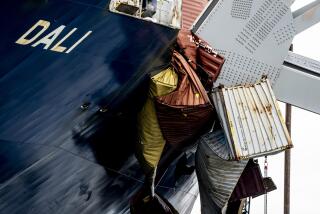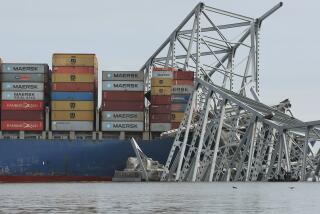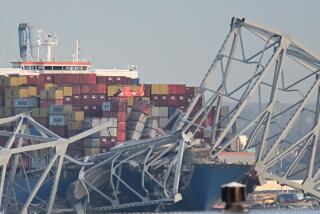London’s Famed Tower Bridge Damaged by Crane on Barge
- Share via
LONDON — A tall crane on a barge banged into Tower Bridge, the Gothic-looking span in central London, knocking part of its fairy-castle superstructure into the River Thames on Monday and forcing its closure to traffic.
The damage was believed superficial, assistant bridgemaster Keith Bywater said. “But there could be loose parts that could come down, so we’ve closed it to pedestrians and traffic. We can’t say how long that is likely to last.”
The closure caused heavy traffic jams in London’s financial district on the north bank of the Thames, where traffic normally loops around the Tower of London to cross the century-old Tower Bridge.
Alan Walburn, a porter in an apartment building on the river’s south bank, said the bridge had opened to let the barge pass upstream at abut 5 p.m., and he heard loud noises as the jib of the crane scraped the two walkways that link the bridge’s two towers 141 feet above the water.
“The jib of the crane scraped under the first walkway and then catapulted into the second,” Walburn said.
Section Knocked into River
The impact knocked an eight-foot section of paneling from one of the walkways into the river.
A police spokesman said the crew of the barge Simpson III was being interviewed to determine how the accident happened.
Bywater blamed it on “some miscalculation on the part of the people on the barge.” The level of the river varies with the tide, which was high at the time of the accident.
The assistant bridgemaster said that structural engineers made an initial examination of the damage but would have to look at it more carefully when it is light today before deciding whether traffic could be permitted.
The cornerstone of the bridge was laid in 1886. It is the most famous of London’s 25 spans over the Thames. It was designed to match the 12th-Century architecture of the nearby Tower of London, and it has blue-and-white painted steelwork with two stone towers that were converted into a museum for tourists visiting the historic section of London.
The high-level walkways that were hit by the crane originally were designed to allow pedestrians to cross the river when the span was open. Now they are used mainly by tourists seeking a high vantage point for viewing city sights.
More to Read
Sign up for Essential California
The most important California stories and recommendations in your inbox every morning.
You may occasionally receive promotional content from the Los Angeles Times.













